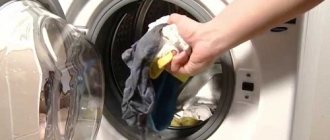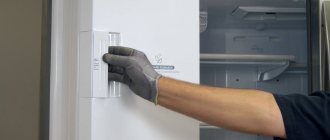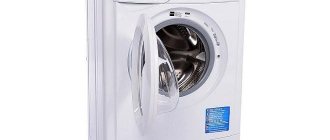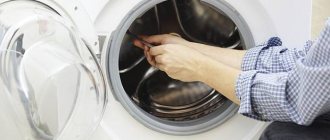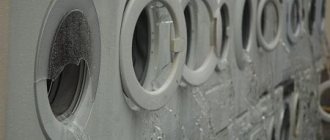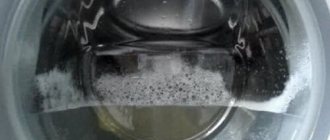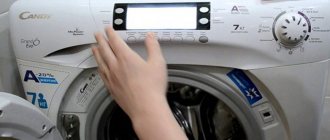There comes a time when even the smartest washing machine begins to act up, refusing to perform the functions assigned to it. You shouldn’t grab the phone to call a repairman if, for example, the machine doesn’t drain the water. It is more practical to spend a little time to understand the cause of the symptom, because many problems can be corrected on your own. Let's figure out why certain breakdowns happen, and which of them are easy to fix on your own.
Some breakdowns can be fixed with your own hands Source protechniky.ru
External manifestations of the problem
A malfunction in which the machine does not drain water is considered one of the most common. Such a breakdown occurs for various reasons; most of them are non-critical and quite fixable. But, no matter what causes the failure, it is externally manifested by the following violations:
- The drain may function, but the process is extremely slow. Additionally, you may notice that the program crashed.
- The program was running as usual, but the process was interrupted just when the drain was supposed to start. Pumping does not start, the program stands still.
- The washing machine works selectively, “according to its mood”: with some loads it drains water regularly, with others it refuses.
- The drain does not start during the rinse cycle, while the main wash runs without any complaints.
- The machine blocks the spin cycle after draining.
The drain filter is hidden behind a hatch on the front door Source lenremont.ru
Call the master
If it is impossible to cope with a clog or breakdown of the Atlant on your own, it is recommended to call a specialist from a specialized washing machine repair company. Such companies are quite widely represented in each region , and they are not difficult to find on the Internet.
From all the variety, it is better to choose those that have been working on the market for years and are responsible for maintaining their reputation. The cost of remuneration for a master depends on the complexity of the situation.
The average prices in the capital are as follows:
replacement of the drain hose - from 1300 rubles;- replacement of the drain filter - from 1400 rubles;
- cleaning the drain filter - from 1100 rubles;
- replacement of the drain pump - from 1,700 rubles;
- finding a blockage in the drainage path and eliminating it – from 1200 rubles;
- repair of the control board - from 2500 rubles;
- removal of a foreign object - from 1400 rubles;
- pipe replacement - from 1600 rubles;
- replacement of the wiring harness – from 1600 rubles.
Replacement parts are paid separately by the customer.
Causes of malfunctions
Almost every housewife has encountered a situation where the machine does not drain water; There may be several reasons for this condition. Most often, the machine refuses to work due to a banal blockage that happens in different nodes:
- There is a blockage in the drain pipe. Small debris from clothing pockets managed to clog the drain pipe connecting the washing machine tank and the drain pump. Due to the blockage, water cannot leave the tank.
- Pump filter clogged. The pump is responsible for draining waste water into the sewer. Small debris (coins, threads, buttons, toothpicks) successfully clogs the filter and stops the operation of the system.
- A foreign object has entered the pump. This happens if the filter was unable to catch the debris. It penetrated further, did not pass through the pump impeller into the drain hose, but jammed it.
- There is a blockage in the drain hose. The debris successfully passed the pump, but clogged the hose through which dirty water is drained.
- There is a blockage in the siphon. Sometimes the drain hose is connected to the sewer network through a siphon. The device extends the life of the washing machine, but, unfortunately, is not immune to clogging.
Filter clogged with threads Source stroy-podskazka.ru
A situation where an automatic machine does not drain water can also arise for other reasons:
- Problems in the electronic unit. Modern washing machines are reliable units, but sometimes they cannot withstand power surges. Electronic control failure sometimes occurs for internal reasons.
- Sometimes programming features of modes are mistaken for a breakdown (this is not typical for all models). For example, some programs do not spin automatically. In this case, the machine pauses and waits for the owner to start the spin manually.
- The machine does not drain water and makes a humming noise. This situation indicates a malfunction of the pump responsible for pumping water. Sometimes it drains, but very slowly.
- The length of the hose was changed after moving the unit. It is rare, but it happens that after lengthening the hose (standard length is one and a half meters), the drain disappears. This can happen if, after a long period of use, the pump’s power has decreased and it cannot pump water over a longer distance.
Clogging is possible in several places Source stroy-podskazka.ru
Sometimes the opposite situation occurs: the machine takes in water without stopping and immediately pumps it out. The reasons can be very different: from failure of the electronics (water level control sensor) to incorrect location of the drain hose.
How to drain water yourself if the drain is not working
It's pretty simple. Stock up on a container with low sides and plenty of dry rags. The water drains through the filter plug. To do this, place the container and open the cap. As the container fills, close the cap, pour out the water and repeat the procedure. So until the SM is completely empty.
Finding and eliminating the cause: procedure
By acting consistently, you can identify the reason why the machine does not drain water, fix it yourself, or (if this is not possible), prepare the unit for the arrival of the technician.
It is convenient if the machine is equipped with electronic control with display output. If the display is working properly, it means that the electronic unit is not damaged; In the event of a malfunction, an error code appears on it. All you have to do is take the instructions, find what is hidden under this code, and decide whether you can fix the problem yourself. If there is no display or no error is detected, check which program is selected and how it was launched.
Most machines have a delicate wash cycle designed for wool, lace and other delicate items. Delicate washing is characterized by a smoother and slower movement of the drum, and the spin cycle is not activated automatically.
In some models, the spin is not activated automatically Source severdv.ru
See also: Catalog of companies that specialize in engineering systems (heating, water supply, sewerage and others) and related work
Before spinning (after rinsing), the washing machine stops. To complete the process, the initial mode is canceled, and then the water pumping program is turned on, following the instructions. If the previous situation is not your case, proceed in the following order:
- Check the drain hose. It may be that water is physically unable to leave the unit because the hose is kinked or kinked.
- Perhaps the problem is not in the washing machine, but in the sewer (or siphon, if there is one). To check the assumption, the hose is carefully disconnected, directed, for example, into a bathtub or sink and the drain mode is started. If it works, the reason has been found; All that remains is to fix it or call a specialist.
If previous efforts did not correct the situation, restart the machine: turn it off for a quarter of an hour, and then try again to start the pumping program. If it does not work, then the cause of the malfunction lies in the machine itself. Before starting to diagnose and correct them, it is recommended to disconnect the device from the network, take out things and drain the water. If you don’t do this, you will have to not only look for and fix the problem, but also get rid of the unpleasant odor.
The position of the drain hose affects the pumping of water Source sitysun.ru
Rules for operating the washing machine
In order for the equipment to work without failures, it must be handled correctly:
- Each model has a certain load limit. If it is exceeded, the unit will “work for wear,” which will significantly increase the risk of problems. Strictly comply with established standards;
- Before washing clothes, carefully check pockets and fittings. They can cause problems with the operation of the impeller, pump or engine;
- To connect the washing machine to the mains, use a surge protector if possible. It will protect equipment from voltage surges;
- Clean the drain filter regularly;
- select the correct washing program;
- Every year, carry out preventative cleaning of the machine without laundry - using washing powder and a special descaling agent.
Follow simple operating rules, then the equipment will work without failures, and washing will always be a joy
Care and compliance with the rules will significantly increase the life of the washing machine.
Video description
How to drain water from the machine in the following video:
Last Possibility: Drain Pipe
If the methods described above do not bring results or are not available (for example, the unit does not have an emergency hose), you can use the possibility of forced pumping through the drain pipe.
You have to resort to draining through the pipe if you were unable to use the filter. The situation indicates a clogged system, so in this case you can not only get rid of the water, but also at the same time eliminate the root cause of the machine failure. The plan is more complex and includes the following actions:
- Remove the back wall to gain access to the pipe (in some models you need to remove the bottom). As a rule, it is located under the drum.
- They put a flat container and thoroughly stock up on rags.
Basic information about problems can be found in the instructions Source stroy-podskazka.ru
- The pipe is disconnected from the pump by removing the clamp.
- If after disconnecting the water does not flow out, then there is a blockage that must be carefully removed with your fingers.
The disadvantage of this method is that it is difficult to implement for most housewives. But it allows you to completely get rid of water and, possibly, fix the damage.
Electrical wiring fault
The washing machine is a heavy and powerful piece of equipment. All its parts, components and mechanisms are subject to increased loads during operation. These include strong vibration, temperature changes and high power consumed by the heating element and electric motor. All this can affect the electrical wiring of the product.
Both during washing and in between work, the following malfunctions may occur:
- Short circuit in the cable. Occurs as a result of a manufacturing defect or in places of inflection. Poor quality or old wiring overheats, the insulation melts, the wires come into contact - short circuit and shutdown of the equipment.
- Loosening contacts. In the machine they are made with bolts and nuts. Due to shaking and vibration during spinning, the connections loosen, unscrew and fall off. The danger of this phenomenon is that the released wire may touch a metal part of the device.
- Oxidation of wires. SMA is installed in bathrooms and kitchens. These are rooms with high humidity. Steam settles on the contacts, which oxidize, causing metal corrosion, leading to the formation of rust. Over time, contact disappears completely.
- Defective plug or socket. A circuit break occurs due to wires falling off the contacts or loose terminals.
All of the above faults can be easily fixed with your own hands. To carry out repairs, there is no need to drain the water from the tank, since all electrical communications are located under the casing. The defect is detected visually or using a tester. After this, the wiring is replaced or the contacts are tightened. It is advisable to replace plugs and sockets with rusty or charred terminals.
Briefly about the main thing
There can be many reasons why the washing machine refuses to drain water. Before calling a technician for help, it makes sense to understand the nature of the faults, because most breakdowns are minor and can be easily fixed with your own hands.
A drainage problem occurs due to a blockage that occurs in the pump, impeller, drain hose or siphon. The pump itself or the electronic unit may be problematic; sometimes the reason lies in a change in the length of the hose. In any case, before doing diagnostics, it is recommended to drain the water and remove things from the tank; There are five ways to do this.
How to prevent filter blockages: editorial recommendations
There are only two simple rules here:
- Clean and rinse the filter as often as possible.
- Before throwing things into the wash, check your pockets and take out everything that is there. Buttons, coins, pieces of rags, papers - these should not get into the pump.
As you can see, the rules are simple and quite easy to follow.
